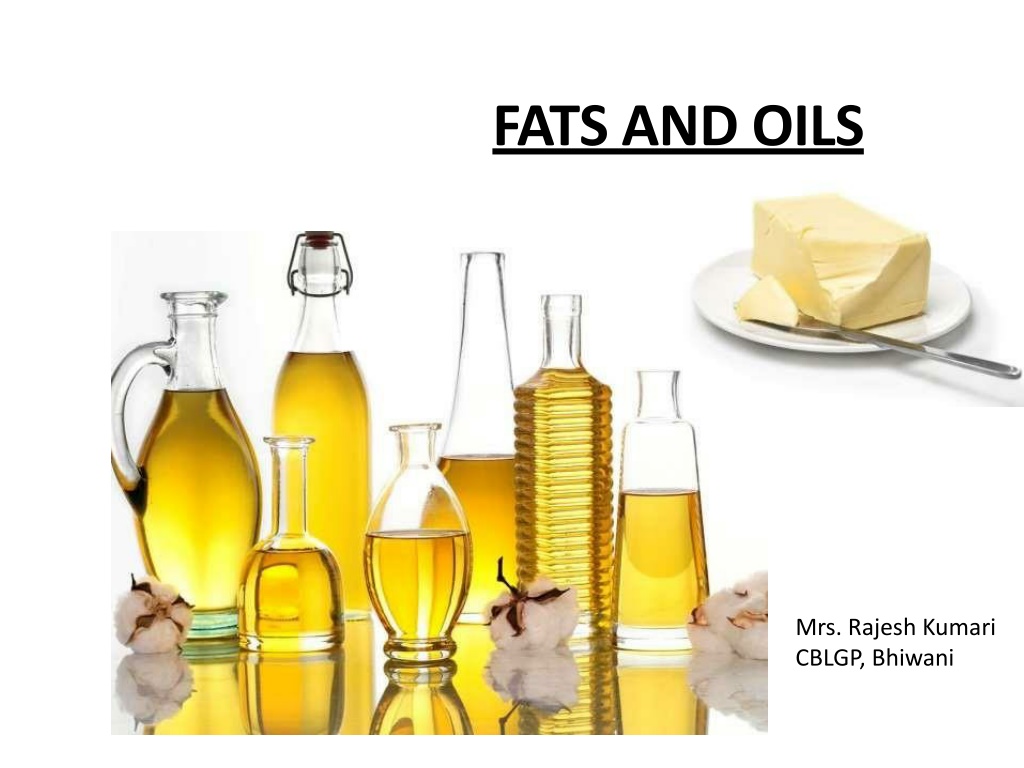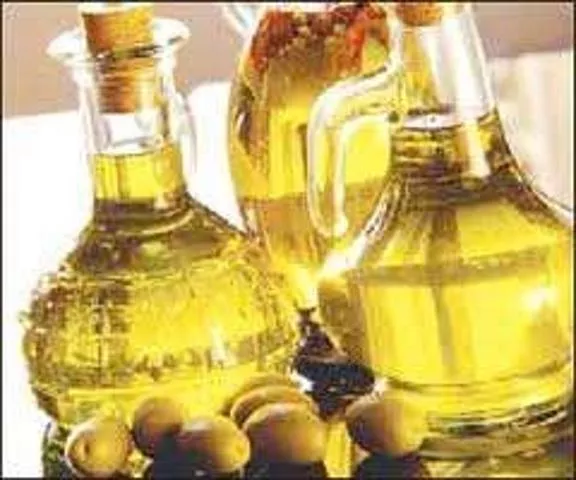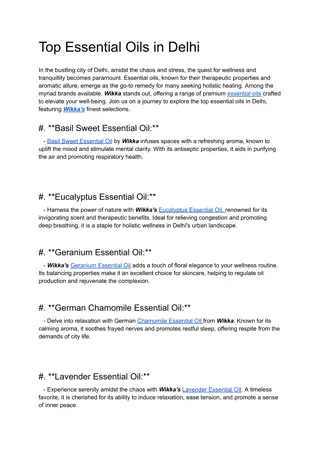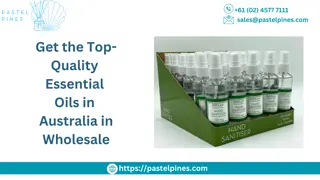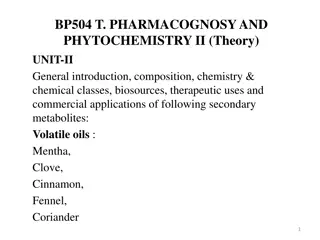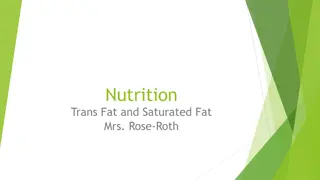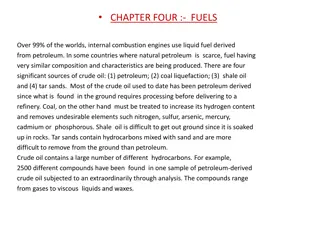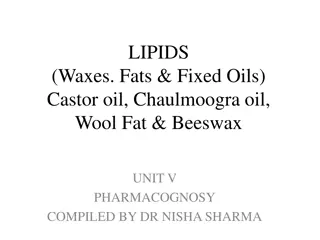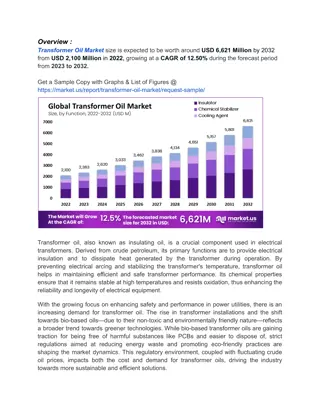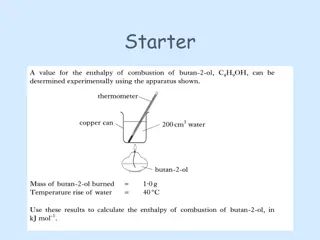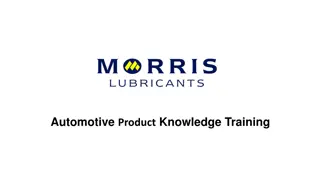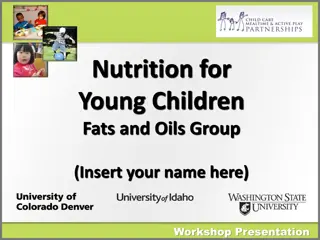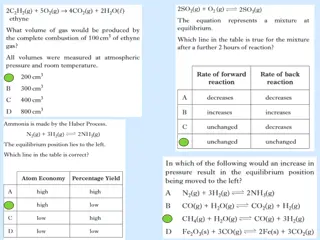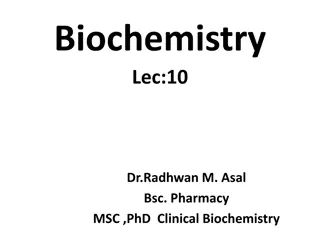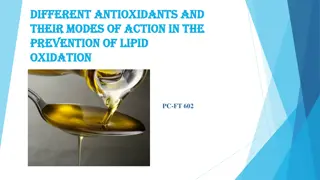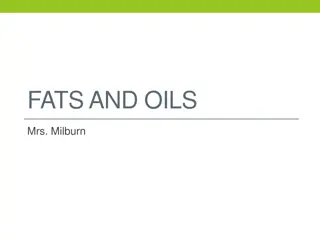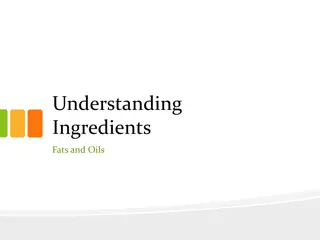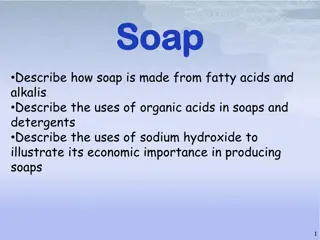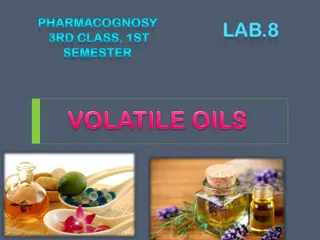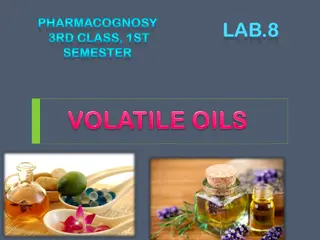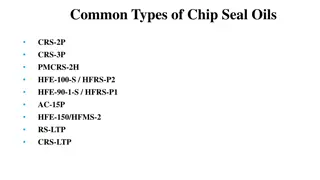Understanding Different Types and Sources of Fats and Oils
Edible fats and oils come from three main sources - vegetable, animal, and fish. Vegetable oils are derived from plants primarily in tropical and sub-tropical regions, such as coconut palm, olive tree, groundnut or peanut plant, and soya bean. Animal fats are also a source of fats and oils. Each source has its unique properties and benefits, making them essential in various culinary and industrial applications.
Download Presentation

Please find below an Image/Link to download the presentation.
The content on the website is provided AS IS for your information and personal use only. It may not be sold, licensed, or shared on other websites without obtaining consent from the author. Download presentation by click this link. If you encounter any issues during the download, it is possible that the publisher has removed the file from their server.
E N D
Presentation Transcript
FATS AND OILS Mrs. Rajesh Kumari CBLGP, Bhiwani
Types and Sources of Fats and Oils Edible fats and oils are obtained from three main sources: vegetable, animal and fish.
Vegetable Oils These are derived from plants which grow in many parts but mainly in tropical and sub tropical regions. The main vegetable oils are obtained from the following. seeds of of the world
Coconut Palm The coconut is harvested when ripe, the outer fibrous husk is removed and the nut exposed. This is then cut in half, exposing the thin white fleshy layer known as the meat . This is the endosperm of the nut. This may be eaten raw or processes into products such as desiccated coconut, or dried in the sun or in kilns. When dried it is known as copra in which state it is exported to countries who extract and refine the oil. The main sources of supply are the Philippines, Oceanis, Malasis and Sri Lanka.
Olive Tree The ripened fruit of the olive tree produces one of the finest of all vegetable oils. The first crushing of the fruit gives the highest grade oil which needs no refining. It is exported mainly by Italy, Spain and Greece.
Groundnut or Peanut Plant The plant produces pods containing the nuts a few inches below the surface of which makes harvesting more complicated than for those previously It is exported as nuts, and as oil, by such countries as West Africa and China. the soil, sources mentioned. Nigeria,
Soya Bean The soya plant, a member of the pea family, producesmany pods which each contain three to four beans on each plant. Although relatively low in oil content (between 13-20 per cent) the soya bean has recently become the leading sources of vegetable oil in the world. It is mainly exported by the U.S.A, China and Brazil.
Animal Fats Animal fats are one of the many by products from the slaughteringof animals for human consumption. Fat in animals naturally and is found mainly as a layer under the skin and also surrounds and protects vital organsof the body such as the kidney and the intestine. The three main sources are from the following. occurs
Beef Animals are the commonly human and a high as a These largest of animals killed consumption quality fat is obtained by-product. Suet is obtained from around the kidneys and shredded. The intestinal fat is processed temperature to products, oleostearin also oil, both of which can be used in the manufacture of margarine. for at low two and produce
Pigs This species tends higher fat ratio animals of to to animal have a meat other therefore quantities available than and large are
Sheep Very small sheeps This is quantities of fat are used. mainly because the fat tends to be than and has a stronger flavour and odour. harder beef or pork fat
Fish Oils These are obtained by the extraction of oil from the whole fish. most suitable are those with a high fat content and these are mainly pelagic type fish such as the pilchard, sardines, anchovies. these are unsaturated oils and are susceptible oxidative attack and must therefore be refined and hydrogenated before being margarine and cooking fats. Fish oils are imported form Peru. Norway and Iceland The fish herring, and Unfortunately to carefully used in
Fats and oils may be classified under the following heading-: i) By their original natural source when possible e.g. animal fats, vegetable oils or marine oils. ii) By their physical state at room temperature and by their chemical nature, i.e. whether they are fats or oils: In order to obtain satisfaction about the oils quality of the end-product, the correct fats and should always be used.
The Functions and Uses of Fats and Oils When cooking
An Ingredient Fats and oils are used as an ingredient in bread, cakes, pastry type of goods etc., for many reasons, in particular the following. Flavour If the fat contains flavour as does margarine, it will impart that flavour to the goods of which it is an ingredient. Any off-flavour such as that form fats that are mildly rancid will also be imparted. A Good Appearance The correct quantity of a quality fat will assist in giving a cooked product an even texture, a better bloom, and a good salable appearance. Some research has indicated that the presence of fat will raise the temperature at which the product sets in its shape.
Keeping Qualities of the Product Fat by its emulsifying action, holds the moisture content of a bread dough and cake batter and assists preventing the bread, cake etc., from drying out too quickly. in Shortening Property of the product All fats are shortening agents that are they reduce the extensibility of the gluten in the flour. The fluten is split up by films of fat which weakens the structure sufficiently to make it tender; giving a product which when cooked is friable and easily broken e., shortbread, short pastry etc.
To obtain a Good Volume When products are made by the creaming process it is the fat which holds the air. Therefore the creaming properties of a fat, or its ability to entrap air, will result in rising taking place uniformly and sufficiently throughout a mixture giving a cooked product of good volume and of uniform grain and texture. To add Nutritional Value to a Product:- Fats are important in the diet, being a concentrated source of energy and a carrier for some important fat soluble vitamins
Shallow Frying The oil or acts as for medium transfer of heat the the item processed partially in the oil or fat. the the to fat food, although being is immersed only
Deep Frying In this method of cooking the oil acts as the medium for the transfer of the from the fryer food(the food being immersed in the hot oil). used for deep frying should have a high smoke point be stable oils and be mainly bland in taste so that there is no evident transfer of flavour from the oil to the food product. heat the fully Oils to
Basting or Roast Meats Basting serves function preventing meat drying giving the meat, adding the of the out, colour to cooked and flavor.
The Difference Between Butter and Margarine
BUTTER Butter is created from cream which rises to the top of milk if it sits for a period of time. Through the process of churning the cream, a chemical reaction takes place which makes the cream begin to solidify. Butter is an excellent source of vitamins A, D, E, and K. None of these fat-soluble vitamins are found in margarine. The best quality butter is made from certified raw cream. Certified raw butter is made up of healthy fatty acids. Toxic metals or trans-fat is not found in butter.
Margarine Margarine is made from vegetable oil that has been extracted chemically and refined. In order to actually make margarine, the oil must be solidified to some degree. It has less saturated fat than butter. Margarine contains trans fats that lower good cholesterol and raise bad cholesterol. According to the Cleveland Clinic, one tablespoon of margarine has 3 grams of trans fat and 3 grams of saturated fat. Vitamin E is destroyed in the oil.
What is smoke point of an oil or fat ? The smoke point of an oil or fat is the temperature at which it gives off smoke. The smoke point of oil depends to a very large extent on its purity and age measurement. A simple rule of thumb is that the lighter the color of the oil, the higher its smoke point. When frying, it is important to choose an oil with a very high smoking point. Most foods are fried between the temperatures of 350-450 degrees Fahrenheit so it is best to choose an oil with a smoking point above 400 degrees. at the time of
Fats or Oils Description Cookin Type of Fat Smoke Smoke g Uses Point F Point C Whole butter is a mix of fats, milk solids, and moisture Butter derived by churning Baking, 350 F 177 C Saturated cream until the oil droplets stick together and can be separated out. cooking coating A heavy nearly s, colorless oil ionary, Saturated 350 F 177 C confect Coconut Oil extracted from fresh coconuts. ing shorten
Smoke Point F Smoke Point C Fats or Oils Description Cooking Uses Type of Fat Margarine, Pale-yellowoil that is salad extracted from the dressings, seedof the cotton shortening. plant. Also used for Polyu nsatu Cottonsee d Oil 420 F 216 C rated frying. cooking, salad dressings, saut , pan fry, sear, Oils vary in weight and may be pale yellow to deep green depending on fruit used and Extra Virgin - 320 F Virgin - 420 F Pomace - 460 F Extra Light - 160 C 216 C 238 C Monou nsatur ated Olive Oil
The Manufacturing Processes for Fats, Oils, and Margarine The fats and oils that are used in the catering trade come from a variety of sources from vegetables, animals, and fish. It is rarely that the raw , unprocessed fat or oil is in a form that can be used straight away without being treated in some way.
The process is in five main stages. Degumming This is the removal of impurities from the crude oil or fat and of substances which will cause the end product to develop off flavours and odours. The crude oil is mixed with a weak salt solution and the impurities are precipitated off into the salt solution which is then strained off. Neutralization This stage does two important things It removes the free fatty acids from the oil which would cause rancidity and it partly bleaches it.
Bleaching The oil is bleached in a process using Fullers earth. This is added to the crude oil while it is under vaccum and the earth absorbs the colour pigments. Filtration The oil is passed through as series of presses to remove the Fuller s earth. filter
Deodorizing This is the final stage in refining in which the volatile impurities are removed by a steam distillation process. The deodorized oil is then filtered again. On completion of this stage the oil e.g a salad or cooking oil is completely ready for any suitable edible purposes.
The Manufacture of Margarine Margarine is a fat bearing a close resemblance to margarine is an proportion of it invented in the ninenteenth century by Mega Mouries, a French man, who was competing in a competition government margarine is and labeling are strictly controlled by legislation. butter. The fat content of dairy fat although a small is permissible. Margarine was organized by the French for a substitute for butter. As a substitute for butter its contents
Hydrogenation This is the process by which oils can be hardened by the addition of them a higher melting point them more stable. Final Refining After hydrogenation it is usual to process the oil again through the stage of neutralization, bleaching and filtering to t\remove the breakdown substances from hydrogenizaiton. hydrogen to give and to make
The Blending of Oil and Fats The manufacturer makes his selection makes his selection of which oils and fats to use on two main criteria, the cost of the raw ingredients and the particular required properties of the margarine to be produced. The wide selection of oils and fats available to the manufacturer enables him to control his raw material costs. The type of margarine to be produced determines the blend of different fats and oils that may be used to give a particular melting point, acceptable spreading ease, and plasticity.
Aqueous Phase This can be just water when the margarine is produced for religious or dietary reasons. Usually, however, it consists of cultured, sweet skimmed milk or reconstituted milk powder. In addition, salt as a brine can be added if required to give a salt content in the margarine of up to 2%. The percentage of salt depends on the type of margarine being produced and which part of the country it is to be sold in.
Addition of Special Ingredients For special ingredients may be added to the fat after the hydrogenization. They are: - Vitamins A and D. The quantity of Vitamin A and D are laid down by the Margarine Regulations. - Colouring matter. A colouring ingredient may be added to give an overall satisfactory colour to the finished product. Flavouring agents. These are usually some of the constituents found in butter such as butyric acid. - Emulsifiers. These are to ensure that the fat and liquid parts of the margarine do not separate out at a, later stage. -
Emulsification The fat blend and the aqueous phase are next mixed and solidified in special apparatus known as a Votator. The mass of fat is then mixed further to become homogeneous. margarine is then packaged. The
Types of Margarine The manufacturing process of margarine allows many types of margarine to be made by: Varying the refined and hydrogenated fats and oils to be used so as to obtain margarines of different plasticity and melting points. Adding if required the permitted 10% milk fat weight) Adding salt if required. Varying the quantity of water (maximum of 16%) (by
